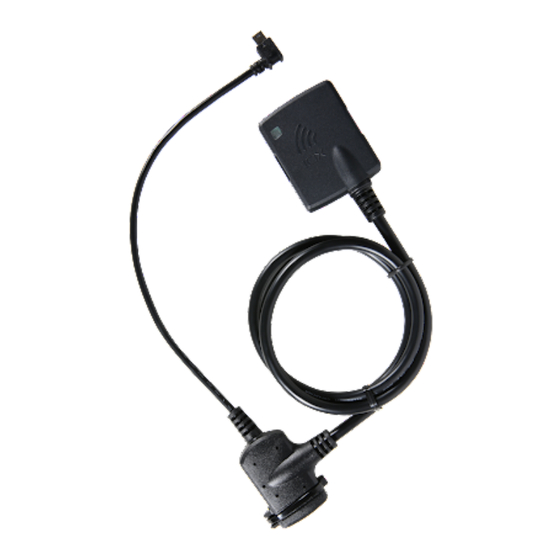
Advertisement
Quick Links
For the most up-to-date version, visit:
The IOX-NFCREADERA integrates Near Field Communication (NFC) with the Geotab
Identify drivers operating vehicles in a fleet at any given time. Users create rules, reports, and exceptions on MyGeotab™ based on individual drivers or vehicles.
Enable vehicle access for Geotab Keyless Platform customers. Users can be granted authorization to unlock and lock vehicle doors.
Features
Easy-to-install IOX™ into the Geotab GO device
Assigns drivers to vehicles, enabling driver-based reporting
Optional feature: Authorized Driver List - allowing only authorized driver ID tags/stickers to interact. For more
information, refer to the
For Keyless customers, allow authorized users to lock and unlock vehicle doors.
IOX hardware technical specifications
Weight
Size
Housing
Interfaces
Frequency
Nominal Input Voltage
Power Output
Current Rating
Temperature Rating
Connectors
Installation
Reading Distance
Compatible Devices
Used in conjunction with:
goo.gl/Sz7JTA.
Driver ID authlist
section.
148 g
Overall Length: 1300 mm L
Widest Point (Antenna): 63 mm L x 49 mm W x 16.5 mm H
Widest Point (Connector): 53 mm W × 15 mm H
Black, moisture-resistant thermoplastic overmold
CAN: 500 kbps (for daisy-chaining)
Ground Switch: For Relay Control
13.56 MHz
12 V / 24 V
Daisy Chaining: 2500 mA @ 12 V/24 V
Operating Mode: 100 mA
Sleep Mode: 1.1 mA
−40 ℃ to +85 ℃
Male Mini-USB Type-B connector: Daisy chain power and CAN in
Female Mini-USB Type-B connector: Daisy chain power and CAN out
2-pin grounding socket (Molex connector)
Male Mini-USB connector connects to the GO device or another IOX
Relay module connects to 2-pin socket
With GEO-NFCSTKBLUA: 19 mm
With GEO-NFCFOBBLUA: 11 mm
With GEO-KLNFCFOB through a windshield (Keyless): 30 mm
Driver Identification: All GO7
Keyless: Minimum GO9
Driver identification:
®
GO™ device to:
®
and newer devices and variants
®
and newer devices and variants
Advertisement

Summary of Contents for Geotab IOX-NFCREADERA
- Page 1 Identify drivers operating vehicles in a fleet at any given time. Users create rules, reports, and exceptions on MyGeotab™ based on individual drivers or vehicles. Enable vehicle access for Geotab Keyless Platform customers. Users can be granted authorization to unlock and lock vehicle doors.
- Page 2 How to install IOX-NFCREADERA 1 Unplug the Geotab GO device from the vehicle and remove the IOX expansion port cover on the GO device. 2 Plug the 90° USB connector from the IOX into the GO device. Secure the USB connector using a zip tie. Please note that over tightening the zip tie may damage the USB connector.
- Page 3 Use cable ties to complete the installation by routing and securing the cable, and connecting the IOX-NFCREADERA to the GO device. 5 Once you connect the IOX-NFCREADERA to the GO device, plug in the GO device and start the vehicle. The GO device enters debug mode.
- Page 4 <Parameter Description="Enable Authorized Driver List" Offset="164" Bytes="8" IsEnabled="true"/> Once the parameter is applied, the IOX-NFCREADERA only accepts driver key tags assigned to an authorized driver. You can add and remove drivers to/from the authlist through the Geotab API (my.geotab.com/sdk/#/api). See the DriverAuthListContent object for more details.
-
Page 5: Regulatory Statements
Connect the equipment into an outlet on a circuit different from that to which the receiver is connected. Consult the dealer or an experienced radio/TV technician for help. Changes or modifications not expressly approved by Geotab could void the user’s authority to operate the equipment. - Page 6 Product Wireless Information 13.56 MHz: Max -1.57 dBuA/m H-Field strength Mexico La operación de este equipo está sujeta a las siguientes dos condiciones: (1) es posible que este equipo o dispositivo no cause interferencia perjudicial y (2) este equipo o dispositivo debe aceptar cualquier interferencia, incluyendo la que pueda causar su operación no deseada.

Need help?
Do you have a question about the IOX-NFCREADERA and is the answer not in the manual?
Questions and answers